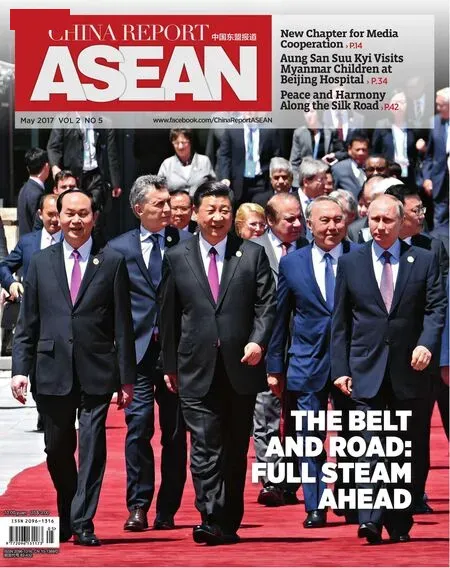YANTAI PLAYS KEY ROLE IN BELT AND ROAD
By
YANTAI PLAYS KEY ROLE IN BELT AND ROAD
ByWang Zhe
Coastal city in eastern Shandong Province has long been at the forefront of China's efforts to open up to the world
As one of the 14 Chinese coastal cities opened to the world in 1984, Yantai of Shandong Province has grown to become one of the leading economies on the Shandong Peninsula. It has served as an important Chinese trade port, with the historical glory of “a bustling port at sunrise, a glittering city at sunset”. Today, as a hub on the 21st Century Maritime Silk Road, Yantai has seized the historic opportunity of the Belt and Road Initiative to pave the way for Chinese indigenous enterprises to “go global” and fi nd new opportunities of cooperation with the countries along the route.
New Vitality from Trade and Investment
According to Yantai’s Implementation Plan for Participating in the Building of the Belt and Road, its total trade volume in goods with the countries along the route is expected to increase about 10 percent annually by 2020. Its overseas investment is expected to grow by more than 10 percent annually. A number of transnational enterprises with strong international competitiveness will be cultivated, and a number of competitive overseas industrial parks and production and processing bases are set to be built. The plan underscores the strategic position of Yantai, designating it as “a hub for twoway opening up, a leader for maritime economic cooperation, a pilot for investment and trade cooperation and a demonstrationcity for Belt and Road construction”. Twenty-one of its overseas investment cooperation projects have been included in the provincial list of major Belt and Road projects.
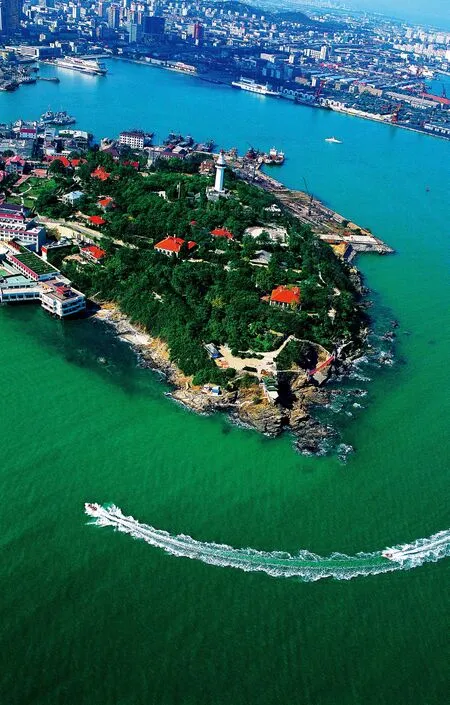
A bird’s eye view of Yantai Mountain.
Yantai has established trade ties with all of the 66 countries along the Belt and Road, 32 of which have invested in 582 projects in Yantai, with overseas investment of US$1.82 billion. Yantai enterprises have invested in 138 projects in 28 countries along the route, the agreed amount of investment being US$1.1 billion.
Yantai is now the co-host of two national-level overseas industrial parks — the Sino-Russian Tomsk timber trade and forestry cooperation zone and the Sino-Hungarian Wanhua-BorsodChem economic and trade cooperation zone. In 2011, Wanhua Chemical paid 1.23 billion yuan (US$190 million) to acquire BorsodChem (BC) of Hungary. Since then, Wanhua has pushed forward the construction of the Wanhua-BC economic and trade cooperation zone, the Sino-Czech international production capacity cooperation zone and the Sino-European R&D cooperation zone in Central and Eastern Europe. The planned area of the Wanhua-BC zone is 6.15 square kilometers, 2.2 square kilometers of which have already been built, hosting 15 Chinese and overseas enterprises.
The Financial Times wrote in an editorial that Wanhua’s BC acquisition represents a“beacon” for other Chinese enterprises on their overseas journey. A large number of Yantai enterprises, such as Nanshan Group, Linglong Tires, Hengrui Group and Dongfang Electronics, are accelerating their overseas operations. The Tomsk Special Economic Zone in central Russia has attracted 19 enterprises from China, the United States and Russia. So far, 316 Yantai enterprises have invested in more than 70 countries around the world, 64 of which are countries along the Belt and Road. The investments have included industrial park development, project contracting, resource mining, product trade, tourism and other areas.
Quantity vs. Quality
Yanjian (Yantai Construction) Group took part in the construction of Sri Lanka’s National Art Theater. The corridor and roof i ng project of the theater won Shandong Province’s fi rst overseas engineering Luban Award (prize in construction quality). The building’s design strongly resembles Sri Lanka’s national fl ower, the lotus fl ower.
Yu Chunyang, general manager of the Yanjian Group International Business Headquarters, said that China’s infrastructure construction industry is saturated with fi erce competition, while the room for growth in infrastructure in other countries along the route remains large. For several years in a row, Yanjian has been in the list of ENR’s Top 250 Global Contractors. In 2017, Yanjian was included in two Top 100 lists of China’s Ministry of Commerce for its high turnover and new contracts.
Having completed jack-up drilling platform projects for Russia and Malaysia, CIMC Raffles — a manufacturer of maritime engineering equipment — agreed on a cooperation project with the Russian energy giant Gazprom’s marine engineering company for maintenance and reconstruction of the Polaris and Aurora semisubmersible platforms, which are located in the Arctic.
Jereh Group, meanwhile, is a global petroleum equipment services provider headquartered in Yantai. Its business revenue last year was more than 4 billion yuan (US$615 million), half of which came from overseas. The group’s vice president Wang Pixue said that competition in China’s petroleum services industry is intense, and prof i ts are diluted. The main growth point of the group’s performance will be on the Belt and Road. Jereh’s overseas business is distributed in more than 60 countries, highly compatible with the Belt and Road.
On October 19, 2016, the Ministry of Agriculture, Forestry and Fisheries of Cambodia signed a memorandum of cooperation with the Tianrui (Cambodia) Agricultural Economic and Trade Cooperation Special Zone in Cambodia’s capital Phnom Penh, marking the official establishment of a Sino-Cambodian national agricultural economic and trade cooperation project. The special zone, Cambodia’s fi rst of its kind, benef i ted from investment by the Shandong Yantai Tianrui Investment Company.
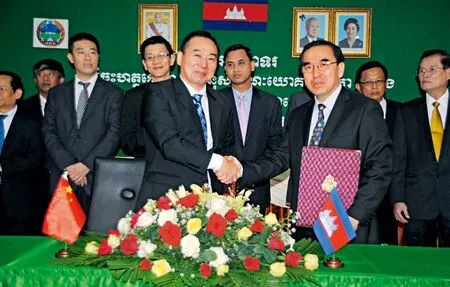
Top left: On Oct. 19, 2016, the Cambodian Ministry of Agriculture, Forestry and Fisheries signed a Memorandum of Understanding on agricultural development with the Tian Rui (Cambodia) Agricultural Cooperation Special Economic Zone, funded by Yantai-based Tian Rui Investment Company.
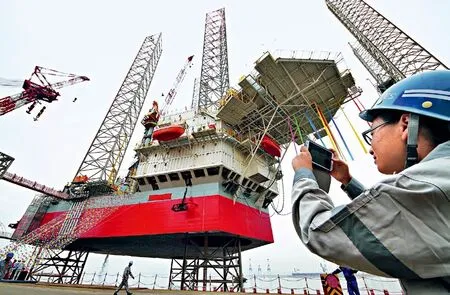
Bottom left: CIMC Raffles handed over the Coastal Driller 4001 jack-up drilling platform to its Malaysian client on Aug. 13, 2014.
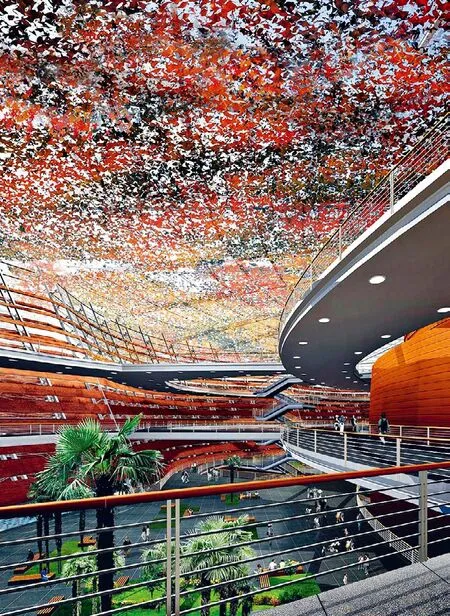
Right: The interior of Sri Lanka’s National Art Theater.
Before the signing of the memorandum, China’s Vice Minister of Agriculture Qu Dongyu signed the Minutes of China-Cambodia Agricultural Cooperation Meeting with Cambodia’s Minister of Agriculture, Forestry and Fisheries Veng Sakhon. The minutes affirm that the Tianrui (Cambodia) special zone is a national-level cooperation project endorsed by the ministries of agriculture of both countries. Both will strongly support the development of the project, so that the project will achieve the goal of “a national agricultural economic and trade cooperation zone” that integrates the upper, middle and downstream parts of the industry chain and focuses not only on R&D, cultivation and planting, but also acquisition, storage and processing, as well as sales, logistics and services.
Cambodia is a largely agricultural country. Cambodian highquality rice has been exported to China, Singapore and Europe. Due to a lack of modern infrastructure, Cambodia’s farming has retained traditional low yield methods. An official at the Tianrui (Cambodia) special zone said he believes that the building of this national-level cooperation project will greatly upgrade the technological level of agricultural production in Cambodia, and promote the development of the whole industry chain, from production to processing, storage, logistics and international trade.
In the future, Yantai will seize the opportunities of China’s free trade agreements with countries along the route, including ASEAN countries, and make the most of the MFN tarif f and non-tarif f measures, as well as relevant preferential policies.
Government’s Role
Yantai has built a 349-squarekilometer China-ROK Industrial Park as a platform for the enterprises of both sides to upgrade their production cooperation.
To build new transport lanes for the Belt and Road, Yantai launched the Penglai International Airport, with an annual passenger throughput of over 10 million. The city also actively pushed forward the planning and construction of the China-ROK railway ferry, the Bohai Strait cross-sea channel and three railway lines including the Bohai Sea Rim high-speed railway. Yantai’s railway link with Longkou and Dezhou to its west will be part of another direct lane to Europe.
Yantai has looked along the Belt and Road for new sister cities, which has contributed to the friendly relations and the people-to-people bonds with the cities. So far, Yantai has established sister city relationships with six cities in fi ve countries along the route— Russia, Bulgaria, Hungary, Thailand and Pakistan. The city has established contacts with Chinese diplomatic missions in 64 countries along the route, as well as their missions in China. The city has also established economic and trade cooperation links with more than 20 major overseas Chinese organizations.
On this journey of “going global”, Yantai has explored the methodology of organizing individual enterprises into groups. Leading enterprises build overseas industrial parks before small and medium enterprises follow in their footsteps. The chemical industrial park that Wanhua built in Hungary is fully equipped with water, electricity, a hospital and a hotel, and includes security with 36 local armed guards. To build a complete industry chain, Wanhua has organized quite a few promotions in China for Chinese enterprises to reside in its fully-equipped industrial park. It’s a win-win arrangement. A success of Tianrui’s agricultural special zone in Cambodia, Linglong’s tire industrial park in Thailand and AVIC Forestry’s Tomsk timber cooperation zone in Russia has demonstrated the benef i ts of cooperation.

